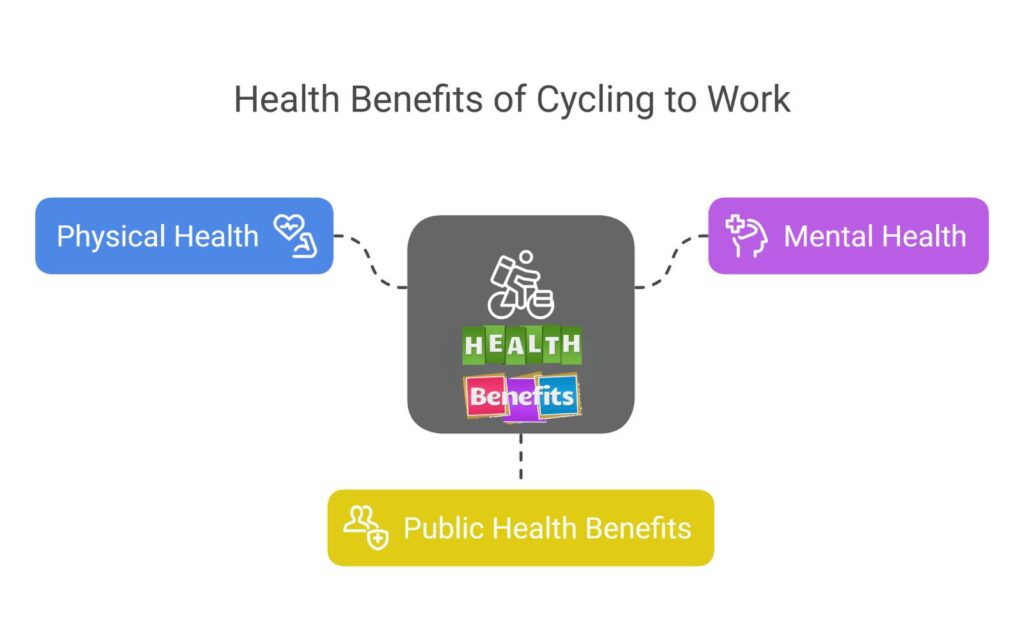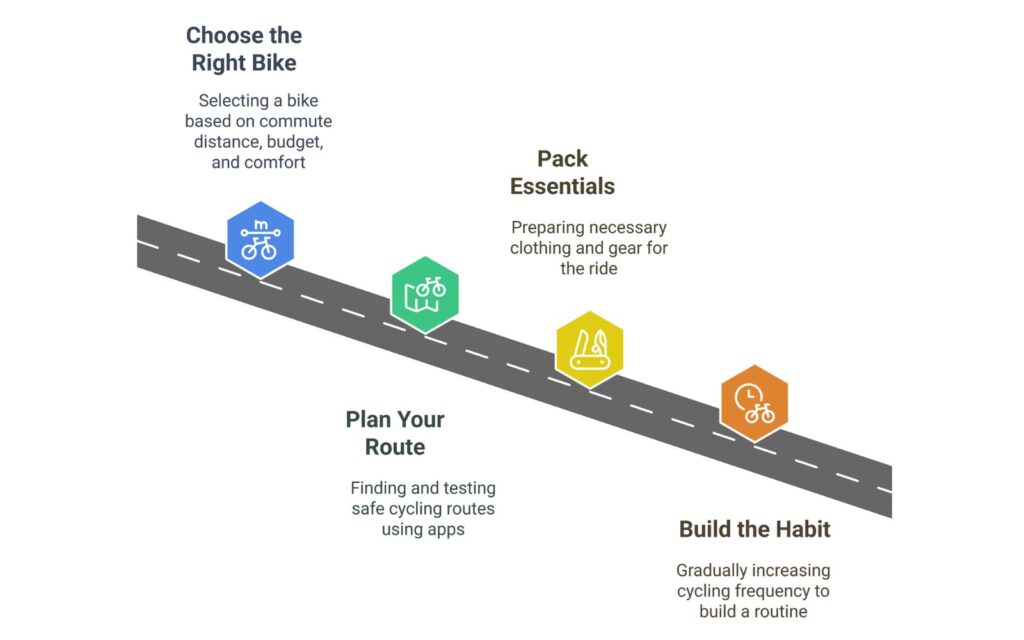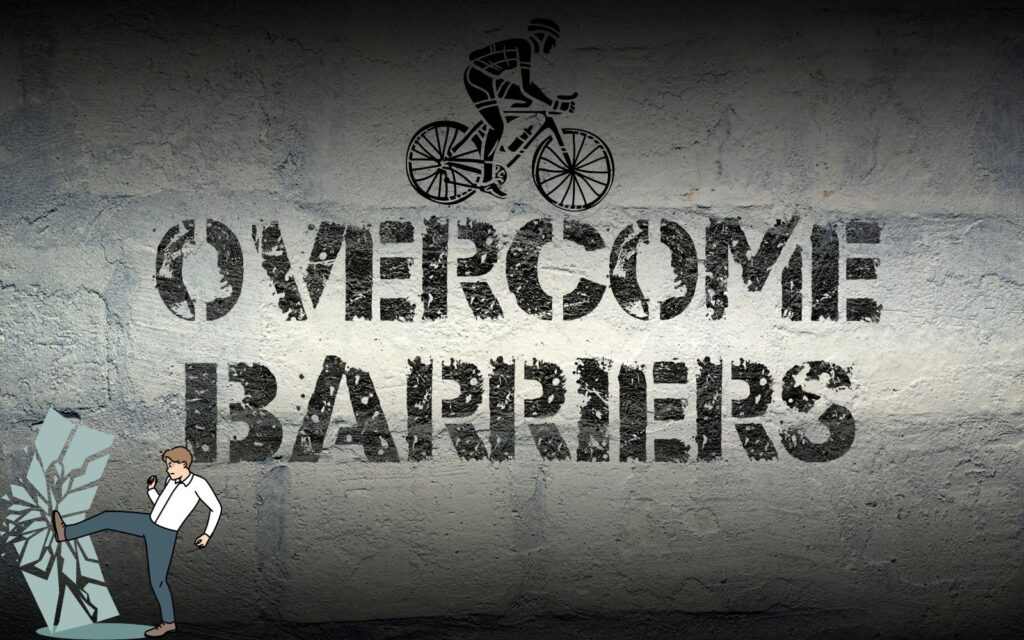Encouraging Cycling to Work for Better Health: Boost Well-Being Today

Most people spend hours commuting to work in motor vehicles, stuck in traffic, or standing on crowded public transport.
But what if your daily routine could also improve your physical health, reduce stress, and help the environment? Encouraging cycling to work for better health is a game-changer.
Cycling is more than just a mode of transport – it’s a low-impact, full-body exercise that improves fitness, helps you lose weight, and lowers the risk of diseases like coronary heart disease and cancer.
Let’s dive into the health benefits of cycling to work and how to make this active commuting habit a part of your life.
Key Takeaways
- Cycling to work improves physical and mental health and lowers the risk of heart disease, obesity, and depression.
- Regular cycling helps maintain fitness and provides a stress-relieving alternative to cars and public transport.
- With the proper cycling infrastructure and tips, you can make bike commuting safe, easy, and enjoyable.
The Health Benefits of Cycling to Work

1. Physical Health: A Natural Boost to Your Well-Being
Cycling is a fantastic form of exercise. It’s low-impact, easy on the joints, and perfect for people of all fitness levels. Here’s how it can help you:
- Lose Weight: Regular cycling burns calories, helping you shed extra pounds while keeping you active.
- Lower Risk of Cardiovascular Disease: Studies show cyclists have a lower risk of heart disease and coronary heart disease than non-cyclists.
- Prevent Chronic Illnesses: Cycling reduces the risk of obesity, high blood pressure, and type 2 diabetes.
- Build Fitness: Daily rides improve overall cardiovascular fitness and strengthen muscles.
2. Mental Health: Say Goodbye to Stress and Anxiety
Cycling strengthens your body and is excellent for your mind. Engaging in physical activity like cycling is linked to lower levels of stress, anxiety, and depression.
- Cycling increases endorphins, improving mood and reducing feelings of depression.
- Time spent riding through city streets or nature allows your mind to relax and disconnect from screens.
- Regular exercise, like cycling, has been proven to enhance sleep quality and leave people feeling refreshed and energized.
3. Cycling’s Public Health Benefits
Encouraging people to cycle to work doesn’t just improve individual health- it benefits the community as well:
- Less Air Pollution: With fewer motor vehicles on the road, cyclists help improve air quality.
- Reduced Healthcare Costs: A healthier population means fewer resources spent on treating diseases like obesity, heart disease, and stress-related illnesses.
- Increased Well-Being: Research shows communities with high levels of active commuting, like cycling and walking, tend to be healthier and happier overall.
How to Get Started with Cycling to Work

1. Pick the Perfect Bike
Choosing the right bicycle is the first step to successful cycle commuting. Consider:
- Commute Distance: Long distances might require a road or hybrid bike, while shorter routes can be managed on a city bike.
- Budget: Start with a good-quality, affordable bike. You can upgrade later.
- Comfort: Test-ride bikes to ensure they fit your height and posture.
2. Plan Your Route and Prep Your Ride
Your cycling route matters as much as your bike. Look for paths with proper cycling infrastructure, such as bike lanes or cycle-friendly streets. Apps like Google Maps or Komoot can help you find the safest and most scenic route.
Test your route on a weekend to get familiar with traffic patterns and potential challenges.
3. Pack Smart for the Ride
Cycling to work doesn’t require a lot of gear, but some essentials will make it easier:
- Clothing: Choose comfortable, breathable clothes, and bring work attire in a backpack or pannier.
- Gear: Invest in a helmet, lights, reflective gear, and a sturdy bike lock.
- Extras: Bring a small repair kit, water bottle, and, if needed, toiletries for a quick refresh.
Some workplaces even provide changing rooms or shower facilities for employees who cycle.
4. Build the Habit Gradually
Not sure you can commit to cycling every day? Start small. Try cycling to work one or two days a week and build up from there.
Set weekly goals and track your progress using apps like Strava. This will keep you motivated and show how much you’ve achieved.
Overcoming Common Barriers to Cycling

“What If My Commute Is Too Long?”
If your workplace is far from home, consider combining cycling with other forms of transport. Ride your bike to a train or bus station and take public transport for the rest of the trip.
“I Don’t Feel Fit Enough to Start.”
Cycling is one of the most beginner-friendly exercises. Start with short, easy rides, and gradually increase your pace and distance. Even cycling for 10–15 minutes daily can have noticeable health benefits.
“I’m Worried About Safety.”
Stick to routes with proper cycling infrastructure, wear reflective gear, and follow traffic rules. With practice, cycling on city streets becomes less intimidating.
“What About Bad Weather?”
Invest in weather-appropriate gear like rain jackets and gloves. With the right clothing, riding in the rain or cold can be enjoyable for many cyclists.
How Employers Can Encourage Cycling

Employers play a big role in making cycling to work easier and more accessible for commuters:
- Provide Bike Racks: A safe place to park bikes encourages employees to choose two wheels over four.
- Offer Incentives: Discounts on bikes, vouchers for cycling gear, or even monetary rewards can encourage active commuting.
- Create Changing Rooms: Facilities with showers and lockers make it easier for employees to freshen up after a ride.
Companies that encourage cycling often see healthier, happier employees and reduced absenteeism.
The Environmental and Social Benefits of Cycling

Beyond health and fitness, cycling also has a positive impact on the environment and society:
- Less Traffic Congestion: More cyclists mean fewer motor vehicles, leading to smoother city streets.
- Improved Air Quality: A shift from cars to bikes reduces harmful emissions.
- Healthier Communities: Active commuting promotes social well-being and creates fitter, happier populations.
Summary
Encouraging cycling to work for better health is a simple, cost-effective way to improve physical, mental, and environmental well-being.
Regular cycling strengthens your heart, helps you lose weight, and boosts your mood while saving money on commuting costs.
Start with the right bike, plan a safe route, and gradually incorporate cycling into your daily routine.
Whether aiming to fight stress, avoid coronary heart disease, or enjoy the ride, cycling to work is a game-changer that benefits you and your community.
Frequently Asked Questions
What Are the Top Benefits of Cycling to Work?
Cycling improves cardiovascular health, reduces stress, helps you lose weight, and contributes to better mental health. It’s also eco-friendly and cost-effective.
How Do I Stay Motivated to Cycle Regularly?
Set small goals, track your rides, and celebrate milestones. Joining a cycling community or finding a buddy can also keep you motivated.
What Safety Tips Should I Follow While Cycling on City Streets?
Wear a helmet, use reflective clothing, and stick to bike lanes or roads with good cycling infrastructure. Always obey traffic rules and stay alert.
Is Cycling Better Than Walking for Fitness?
Both are excellent forms of physical activity, but cycling burns more calories and covers greater distances, making it ideal for commuting.
Can I Combine Cycling with Public Transport?
Absolutely! Many commuters use their bike for part of the journey and switch to public transport for longer distances. This hybrid approach works well for city commuters.





